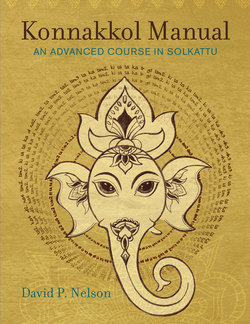Читать книгу Konnakkol Manual - David P. Nelson - Страница 11
На сайте Литреса книга снята с продажи.
Оглавление2 · WHAT IS THIS THING CALLED TĀḶA?
This chapter sketches some important sources for modern tāḷas. There are other treatises, for example, Sarngadeva’s (1210–1247) Sangita Ratnakara, that include tables of tāḷas, but these do not exert much influence over modern (1700–present) musical practice, so I have not listed them here.
NĀṬYAŚASTRA (CA. 200 BCE–200 CE)
This treatise on dramaturgy includes only tāḷas deemed appropriate for songs used in the dramatic productions it describes. It details three features that are relevant to modern tāḷa.11
The Use of a Spatial Metaphor in the Naming of Tāḷa Groups
Only two classes of tāḷa, caturaśra (cha • toor • ash • ra, “four sides”) and tryaśra (tree • ash • ra, “three sides”) are fit for these songs. Even now, sixteen centuries later, the shortest tāḷa cycle comprises three beats.
The Use of Hand Gestures (Kriyās) for Counting the Tāḷas
Musicians were seated so that they could maintain eye contact, enabling them to synchronize their tāḷa gestures. These gestures were grouped into patterns (aṅga), including one called laghu. Tāḷa counts were composed of mātrā, defined as the time it takes to speak five short syllables.12 The laghu is still a feature of modern tāḷas from the thirty-five tāḷa scheme, while the word mātrā has come to mean, at least colloquially, what I refer to here as “pulse.”
A Notion of Expanding and Contracting Form
Tāḷas could exist in compressed and expanded states, which is still the case. Ādi tāḷa, for example, exists in two very common (and other not so common) states; one comprises one count per beat (oru kaḷai), while the other comprises two counts per beat (reṇḍu kaḷai)
Tāḷas at this time were not used in the “cyclic” way they are now, in which an entire song is generally composed within a single tāḷa. Rather, they were strung together throughout a song in whatever order the composer wished.
SULADI SAPTA TĀḶAS (PURANDARA DASA, 1480–1564)
Purandara Dasa, often referred to as the “father” of Karṇāṭak music, left no treatise, but provided vocal exercises (alankaras) in seven tāḷas, made up of three aṅgas: laghu, indicated by a vertical line (|); drutam, indicated by a circle (O); and anudrutam, indicated by a semicircle (U). Drutam and anudrutam were (and are still) of fixed durations, two beats and one beat respectively, while the laghu, at least in this group of exercises, could be three, four, five, or seven beats long, depending on the tāḷa. The laghu is counted by a clap of one hand against the other, or against the leg. The drutam is counted as a clap and a wave of the hand, and the anudrutam is counted by a clap. Claps are conceived as “sounded” counts, while finger counts and waves are considered “unsounded.” More than six centuries later, every Karṇāṭak music student learns these alankaras, typically in three levels of speed (four, two, and one pulse per note within a constant tempo).
THE THIRTY-FIVE-TĀḶA SCHEME
This was first seen in print in 1893 in “Oriental Music in European Notation,” a journal published by A. M. Chinnaswamy Mudaliar. It lays out the full structural possibilities implied in the suladi sapta tāḷas. It maintains the seven tāḷas of the previous scheme, but now each can have five durations, depending on the length of its laghus. Each of the five possible laghus is conceived as belonging to a jāti, or metric “family.”
Caturaśra (now pronounced cha • toos • ra and spelled in this volume as catusra), 4 total beats, a clap + 3 finger counts
Tiśra (corrupted from tryaśra), 3 total beats, a clap + 2 finger counts
Miśra, 7 total beats, a clap + 6 finger counts
Khaṇḍa, 5 total beats, a clap + 4 finger counts
Sankīrṇa, 9 total beats, a clap + 8 finger counts
This results in thirty-five tāḷas, which can be expressed as “n jāti, x tāḷa,” where n refers to one of the five jātis, x to the tāḷa structure. Each beat is now referred to as an akṣara.
Each of these can be further expanded by changing the internal pulse total of each beat. This is called gati (Skt) or naḍai (Tamil), literally “way of walking.” There are five of these, corresponding to the five jātis. This first was printed in “South Indian Music,” by P. Sambamoorthy, first published in 1963.
Catusra, 4 pulses per beat
Tiśra, 3 pulses per beat
Miśra, 7 pulses per beat
Khaṇḍa, 5 pulses per beat
Sankīrṇa, 9 pulses per beat
One hundred seventy-five possible tāḷas have now been generated from the original seven. Unless the gati or naḍai is otherwise specified, the general assumption is that the naḍai is catusra, or four pulses per beat.
